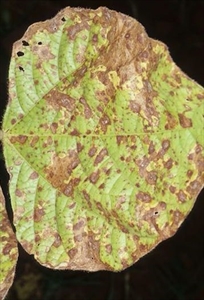Bean Cercospora leaf spot, Cercospora leaf spot
Pacific Pests, Pathogens, Weeds & Pesticides - Online edition
Pacific Pests, Pathogens, Weeds & Pesticides
Bean Cercospora leaf spot (301)
Cercospora canescens. It is considered by some taxonomists to be identical with celery early blight, Cercospora apii (see Fact Sheet no. 136), and the same as cowpea Cercospora leaf spot, Pseudocercospora cruenta (see Fact Sheet no. 303).
Recorded from most countries in Oceania: American Samoa, Australia, Cook Islands, Federated States of Micronesia, Fiji, French Polynesia, Guam, Kiribati, Marshall Islands, New Caledonia, New Zealand, Niue, Palau, Papua New Guinea, Samoa, Solomon Islands, Tonga, Tuvalu, Vanuatu, and Wallis and Futuna.
Many members of the legume family (Fabaceae), including Calopogonium mucunoides, Crotalaria juncea, Desmodium tortuosum, Lablab purpureus, Macroptilium atropurpureum, Phaseolus lunatus (lima bean), Phaseolus vulgaris (French bean), Psophocarpus tetragonolobus (winged bean), Vigna marina, Vigna radiata (mung bean), Vigna unguiculata ssp. sesquipedalis (long bean), Vigna unguiculata ssp. unguiculata (cowpea). The host range will be wider if Cercospora apii is accepted as being the same as Cercospora canescens.
A fungal disease which affects mostly older leaves.
The spots start as small brown flecks, expanding to brown round to slightly angular spots with grey centres up to 1 cm diameter (Photos 1-3). The spots have reddish-brown margins, sometimes with yellow halos. The spots dry and pieces fall out giving a ragged look. The fungus also causes spots on the pods and grows inside them.
Spread is by spores in wind and rain. Survival between crops is on seed, and in crop debris. It may also survive on weeds.
A minor disease that is unlikely to affect yield. Usually, it occurs on the older dying leaves.
Look for the brown round to angular spots on the older leaves with greyish centres and darker margins, up to 1 cm diameter.
CULTURAL CONTROL
Before planting:
- Use wide spacing, 50 x 30 cm, so that air movement dries the leaves quickly after rains.
- Avoid overlapping crops, preventing spores from older crops infecting newer ones. If not possible, then plant the newer crop far from those established already.
During plant growth:
- If practical, prune the older infected leaves when spots are first seen to prevent further spread of spores.
- Weed regularly.
- In commercial plantings, use drip irrigation. If using overhead irrigation, time it so that plants dry out rapidly after watering.
After harvest:
- Collect and burn or plough in trash.
- Practice crop rotation, using maize or sorghum, or root crops, between crops of legumes planted on the same land.
RESISTANT VARIETIES
There are less susceptible varieties of cowpea and mung bean.
CHEMICAL CONTROL
Treat seed with thiram, captan or mancozeb. It is very unlikely that fungicides will be required to control this disease in the field; if they are required, use mancozeb or copper.
____________________
When using a pesticide, always wear protective clothing and follow the instructions on the product label, such as dosage, timing of application, and pre-harvest interval. Recommendations will vary with the crop and system of cultivation. Expert advice on the most appropriate pesticides to use should always be sought from local agricultural authorities.
AUTHORS Grahame Jackson & Eric McKenzie
Information from Diseases of vegetable crops in Australia (2010). Editors, Denis Persley, et al. CSIRO Publishing; and (including Photo 1-3) McKenzie E (2013) Cercospora canescens: PaDIL - (http://www.padil.gov.au); and from Cercospora canescens (CERCCN) (undated) EPPO Global Database. (https://gd.eppo.int/taxon/CERCCN).
Produced with support from the Australian Centre for International Agricultural Research under project PC/2010/090: Strengthening integrated crop management research in the Pacific Islands in support of sustainable intensification of high-value crop production, implemented by the University of Queensland and the Secretariat of the Pacific Community.






